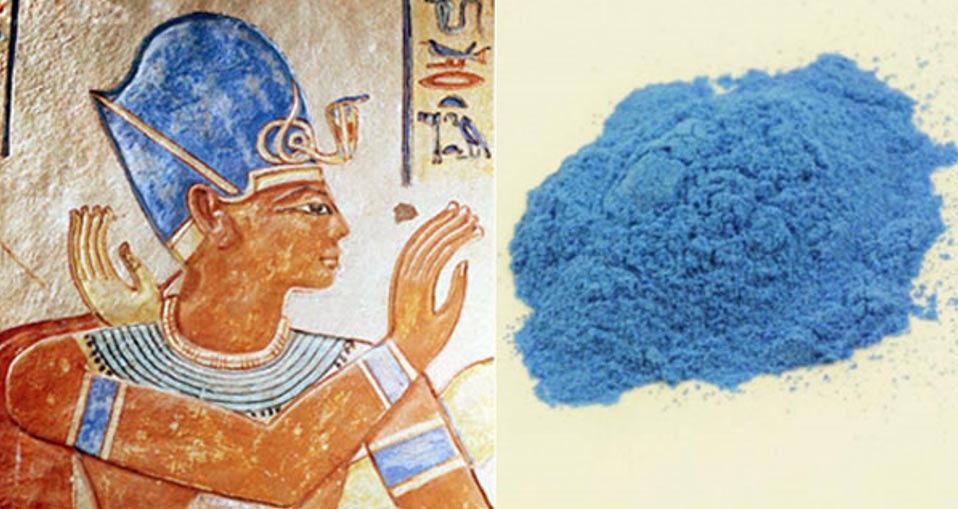Experts discover traces of rare artificial pigment on Egyptian mummy portraits and panel paintings
Egyptian Blue is one of the first artificial pigments known to have been used by man. First created around 5,000 years ago by heating a mixture of a calcium compound, a copper-containing compound, silica sand and soda or potash to around 850-950 C, the precious pigment was reserved for the most exquisite of artworks. In Egyptian belief, blue was considered the color of the heavens, and hence the universe. It was also associated with water and the Nile. However, scientists have now found traces of the rare pigment behind drab-colored mummy portraits, leading to a new understanding of how this particular pigment was used by artists in the second century A.D.
The 15 Egyptian Mummy portraits and panel paintings date from the Roman era. They have rested undisturbed for the last 100 years but scientists and art conservation specialists from Northwestern University and the Phoebe A. Hearst Museum of Anthropology have now dusted them off and begun to investigate. The collection was excavated between December 1899 and April 1900 at Tebtunis (modern Umm el-Breigat) in Egypt’s Fayum region. It includes 11 mummy portraits and 4 panel painting fragments which are now kept at the Hearst Museum at the University of California, Berkeley.
The mummy portraits are extremely fragile. They are lifelike paintings depicting specific individuals which would be incorporated into the mummy wrappings and placed directly over the person's face. This style of artwork appeared in Egypt during the 1st Century AD, remaining popular for around 200 years. In some cases, it has been possible to date the mummy from the hairstyles, jewellery and clothing depicted in the portrait.
The team discovered that the materials used on six of the 15 paintings by the painters nearly 2,000 years ago included Egyptian Blue pigment which they used for the underdrawings and for modulating the colour. The discovery is a complete revelation, given that Egyptian Blue has to be manufactured and so is normally reserved for precious artworks and goods rather than hidden beneath other colours.
- Egyptian Blue – The Oldest Known Artificial Pigment
- Han Purple: A 2,800-year-old artificial pigment that quantum physicists are trying to understand
- Glass beads link King Tutankhamun and Bronze Age Nordic women

Roman-era Egyptian mummy portraits from the site of Tebtunis, Egypt, with no apparent blue color, but under testing, researchers found the synthetic pigment Egyptian blue present in all three paintings. Credit: Phoebe A. Hearst Museum of Anthropology, University of California, Berkeley.
“This defies our expectations for how Egyptian blue would be used” said Marc Walton, speaking to Phys Org. Walton is a research associate professor of materials science and engineering at Northwestern University and an expert on the colour blue. “The discovery changes our understanding of how this particular pigment was used by artists in the second century A.D. I suspect we will start to find unusual uses of this colorant in a lot of different works of art, such as wall paintings and sculpture.”
Egyptian Blue was used extensively throughout the Mediterranean before the Greek period, particularly in frescoes, on temple walls and other locations in order to depict the night sky. It was initially developed by the Ancient Egyptians around 3200 to 3000 BC and was made from silica, lime, copper and alkali. The pigment was the first to be made artificially and was inspired by the naturally occurring lapis lazuli, a semi-precious stone that is coloured deep blue with golden flecks of pyrite, creating a shimmering effect resembling stars in the sky. Although commonly associated with Ancient Egypt, lapis lazuli was also used to fashion jewellery and other items in Mesopotamia, Persia, Greece and Rome.

Egyptian painting with an obvious use of the pigment Egyptian Blue. ‘Hunting in the marshes’ (fragment), tomb chapel of Nebamun. Credit: British Museum.
When the Greek painters rose to prominence in the ancient world they utilised mostly yellow, white, black and red, the four colours in their palette. The Greek painters were considered to be masters of the art, causing the Romans to try and emulate them. As a result, Egyptian Blue was dropped from the Roman palette, or so it has been thought until now.
“When you look at the Tebtunis portraits we studied, that's all you see, those four colours” Walton added. “But when we started doing our analysis, all of a sudden we started to see strange occurrences of this blue pigment, which luminesces. We concluded that although the painters were trying hard not to show they were using this colour, they were definitely using blue. We are speculating that the blue has a shiny quality to it, that it glistens a little when the light hits the pigment in certain ways. The artists could be exploiting these other properties of the blue colour that might not necessarily be intuitive to us at first glance.”
The collaboration between the two groups of specialists is part of the Northwestern University-Art Institute of Chicago Center for Scientific Studies in the Arts (NU-ACCESS), where Walton is a senior scientist.
According to art conservator Jane L. Williams, who is employed by the Hearst Museum and a co-author of the study alongside Walton, the findings confirm the distinction between the visual and physical natures of artefacts. The painters manipulated a small palette of pigments, including Egyptian Blue, in order to create a much broader spectrum of colours. Williams had a range of unanswered questions about the paintings concerning the materials and techniques used by the artists. However, Hearst Museum does not have a conservation science division and so working with the scientists from NU-ACCESS has enabled a comprehensive technical survey of the paintings, including the use of the latest technology for non-destructive analysis. A set of analytical techniques, such as such as X-ray fluorescence and X-ray diffraction, allowed the team to uncover the surprising way in which Egyptian Blue was used.
The team have published their findings in the journal Applied Physics A, which is dedicated to materials science and processing. The research is ongoing and will contribute to Ancient Panel Paintings: Examination, Analysis and Research (APPEAR), an international collaborative study project initiated by the J. Paul Getty Museum. APPEAR is aiming to create an international digital database incorporating historic, technical and scientific information on Roman Egyptian portraits.
Featured image: Left: Egyptian blue shown in an image of Ramses III 1170 BC. Image source. Right: Egyptian Blue pigment. Image source.


















Comments
According to the "experts" at National Geographic, the ancient men were "dumb cavemen" that never had a word for blue. Honest to goodness, they didn't know "Auser/Osiris MEANS Azure/blue.